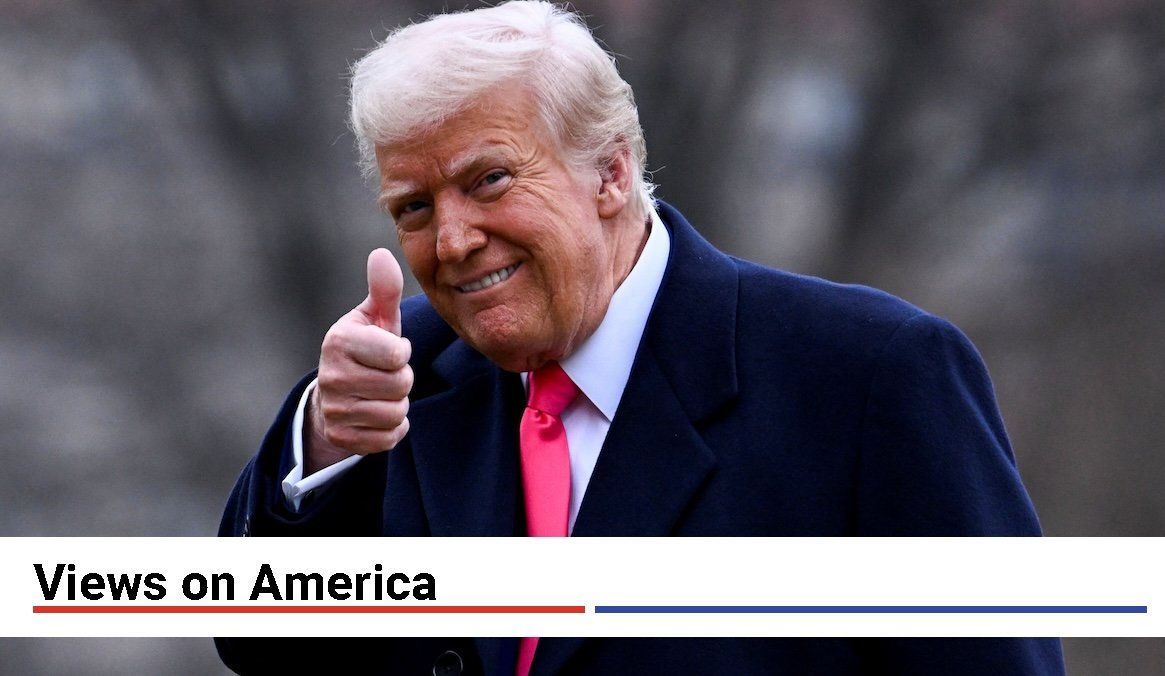President Donald Trump gives a thumbs up as he returns to the White House on Feb. 22, 2025.
World leaders and the global audience are trying to adjust to so much change in such little time, but the dominant thread has been the surprises hidden in plain sight throughout these last three months.
Border security & budget cuts take center stage
At home, the administration immediately got to work on commitments made on the campaign trail and in the latest Republican platform. Atop the list was a mandate to reverse “open-border” immigration policies and secure the US frontier. In its “Protecting the American People against Invasion” presidential action, one of a flurry of Day 1 executive orders, Trump established the groundwork for a multipronged policy, which has included detentions and mass deportations, designating MS-13 a foreign terrorist organization, and court battles over the protected status of Venezuelan migrants as well as birthright citizenship. The approach has had a chilling effect on immigration, with southwest land-border encounters down more than 90% year-on-year, according to the latest March data.
Trump’s other major domestic campaign priorities, deregulation and reigning in federal spending, have spawned a similar pace of action. Elon Musk’s work overseeing the Department of Government Efficiency has come to symbolize how the contours and shape of the US federal government have been redrawn. Last week’s announcement by Secretary of State Marco Rubio that his department will also be overhauled – reducing jobs, shuttering “redundant” offices, and reprioritizing departmental focus – is just the latest example of a campaign throughline to reevaluate federal government spending and structure. The news comes as local governments and populations are still adapting to the shuttering of USAID, a key lever of US soft power abroad.
On domestic policy, there have been few surprises. Trump’s 2024 campaign commitments have become Trump 2.0 administration policy. Despite efforts last fall by the Trump campaign to distance itself from Project 2025, co-author Russell Vought’s selection to lead the Office of Management and Budget was a clear and present signal to all market players of how expansively the plans currently unfolding had been laid.
Remaking America’s role abroad
Turning to the global stage, Trump 2.0’s America First foreign policy has not been the “Make America Great Again” isolationism of Trump 1.0. Instead, from Canada to Mexico, Greenland, and Yemen, no stone is being left unconsidered or unturned. Global expectations set by the first Trump administration that foreign policy would only play second fiddle to a brighter spotlight on the domestic agenda are being updated. Trump has begun to remake America’s role in the world in his image, sowing a geopolitical unsettling but being transparent about the administration’s intentions – as peacemakers and trade disrupters.
As a would-be peacemaker, the president had hoped to bring an efficient closure to the war in Ukraine, an ambition welcomed by those sitting in European capitals. He committed initially to ending the conflict on his first day in office but later extended the timeline to within six months. Last week’s decision by lead attaché Steve Witkoff and Rubio to pull out of peace talks in London is telling. With remaining wide gulfs between Ukrainian President Volodymyr Zelensky and Trump (even after their 15-minute tête-à-tête at the pope’s funeral this weekend), and likewise, between Zelensky and Russian President Vladimir Putin, the US administration is quickly discovering that intractability is in the details. European leadership has yet to identify an offramp to the conflict that does not include the US administration’s stewardship.
As a quick resolution does not appear imminent, the Trump administration may soon look to quietly back out and close the door on its peace negotiation efforts. Rubio acknowledged as much over the weekend, saying that “we cannot continue … to dedicate time and resources to this effort if it is not going to come to fruition.”
Any reduction in attention on Ukraine and Europe would almost certainly coincide with a ramp-up toward the Middle East, where the administration has historically had more success (e.g. Trump 1.0’s Abraham Accords).
While being a peacemaker remains a work in progress, the president has exceeded expectations as a trade disrupter over the first 100 days. Despite Trump’s constant refrain of tariffs and a four-decade commitment to seeing the US not get “ripped off,” the markets and global leadership still held their breath for a targeted, gradual installation of levies. Instead, April 2, aka “Liberation Day,” introduced the world to one man’s concept of “kind reciprocity,” a benign phrase that has the potential to reshape the global trading system, financial markets, and international relationships.
The accompanying executive order provided for a 10% flat tariff on all trading partners, which went into effect earlier this month. The additional “discounted” reciprocal tariff rates to be imposed on certain trading partners were postponed for 90 days until July 9 for all except the People’s Republic of China. In the intervening weeks, markets have wobbled but are holding onto hope.
The dominant question now is what lies ahead for the next 100 days and beyond. As the “Liberation Day” announcements and maneuvers clarify, there will be more volatility to come. Even with the policy priorities and details beginning to be filled in, this is not the finishing line; it is merely the starting gun. Trump has 90% of the race still to run.
Still, the Trump administration will be pleased with the scorecard of promises kept thus far. It has planted seeds across the domestic and global landscape and will now step back to watch the garden grow. On trade, the ambition is 90 deals in 90 days. And with it, Trump assumes his most preferred role: dealmaker-in-chief.
Lindsay Newman is a geopolitical risk expert and columnist for GZERO.
